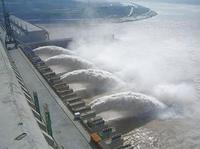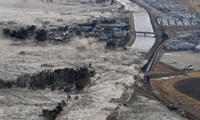-
CAST Lighting’s LED Perimeter Light wins industry innovation award
The task of illuminating long perimeter fences has always been problematic; installing tall pole-mounted luminaires to flood fence regions with light is expensive in material and labor and wastes energy, since most of the illumination falls outside the perimeter region; typical metal halide pole-mounted lamps would require nearly 4,000 watts to light 500 feet of fence; CAST Lighting’s LED Perimeter Light uses just seven watts per luminaire, thus illuminating 500 feet of fence with less than 150 watts of power, saving 96 percent on energy costs; the new LED Perimeter Light captured the industry coveted innovation award at LightFair International 2012
-
-
$90 million contracts for developing anthrax vaccine and antitoxin
HHS awards two companies contracts with potential value of $90 million for the advanced development of a novel next-generation anthrax vaccine and a new type of anthrax antitoxin
-
-
FutureSentry, Sun Surveillance offer solar-powered intrusion detection
Two companies join forces to offer solar-powered automated intrusion detection systems for areas with limited power; the solution enables a cost-effective deployment as there is no need to trench and pull video cable and power, saving on both installation cost and time
-
-
Tyco International acquires Visonic
Tyco International acquires Visonic, a specialist in electronic security systems; the acquisition will strengthen Tyco Security Products’ business in the intrusion security market
-
-
Autonomous multi-target, multi-user tracking capability
An autonomous multi-sensor motion-tracking and interrogation system reduces the workload for analysts by automatically finding moving objects, then presenting high-resolution images of those objects with no human input
-
-
Hydropower gaining traction around the world

As more nations turn to renewable energy sources, wind and solar have often grabbed all the attention, but hydropower has been steadily making quiet gains. While hydroelectricity is becoming more prevalent, its future is riddled with uncertainty and difficult questions; in 2008, hydroelectricity generated more than 250 billion kilowatthours of electricity, roughly 67 percent of all renewable energy produced that year; new dam projects are also generating a lot of criticism from environmentalists and local residents who worry about the people who will be displaced as well as the dams’ environmental impacts; ironically hydroelectric dams will be affected by climate change, the very thing it is designed to combat
-
-
Japanese government anticipated tsunami's effects at nuclear plants

Growing evidence suggests that the Japanese government and Tokyo Electric Power (TEPCO) ignored clear warnings that infrastructure at the Fukushima Daiichi power plant would be damaged in the event of a massive earthquake; Japan’s Mainichi Daily recently obtained government documents that indicate a government research group clearly outlined the effects of tsunamis on nuclear plants; as TEPCO battles to contain the radiation spewing from the Fukushima Daiichi reactors, the power company and the government have insisted that the 11 March earthquake and tsunami that knocked out cooling systems at the Fukushima Daiichi plant was well beyond their expectations
-
-
Study finds natural gas releases twice as much greenhouse gas as coal
A new study shows that natural gas is not as environmentally friendly as previously thought, dealing a major blow to environmentalists who viewed it as a “bridge fuel” to cleaner energy alternatives; researchers found that the greenhouse-gas footprint of shale gas over a twenty year period was at least 20 percent higher than coal and could even be “more than twice as great”; the study was quick to draw criticism from oil and gas companies for its use of shoddy data; the study also outlines multiple ways that the oil and gas companies could reduce methane emissions by up to 90 percent during the drilling process
-
-
Intrusion detection company joins chemical society
The growing attention to chemical plants safety leads perimeter security companies to show even more interest in that sector; Senstar, a manufacturer of perimeter intrusion detection technology, joins the Society of Chemical Manufacturers and Affiliates
-
-
New guide explains perimeter protection options
A new guide explains the subject of perimeter protection clearly and concisely to enable specifiers, facilities managers, security managers, and consultants to identify the optimum security measures for particular premises and threats; it covers not only high-security fencing, barriers, and gates, but also electric pulse systems and associated security measures such as access controls, CCTV, and intrusion detection systems
-
-
New radar optimized for homeland security
A new radar is designed to provide an affordable, modular solution for border protection and coverage of wide areas, offering good detection capability of ground targets and aerial targets, specifically homeland security-relevant objects flying slow at very low level
-
-
Biosensor improves pathogen detection in food, water
A nanotechnology-based biosensor being developed by Kansas State University researchers may allow early detection of both cancer cells and pathogens, leading to increased food safety and reduced health risks
-
-
Smart fence distinguishes real from imagined threats
A new sensor system can tell between someone simply leaning against a fence and a ne’er-do-well sneaking around; the device, developed by researchers at the University of Southern California, contains signal processing based on the way the brain works
-
-
Arizona County to fingerprint employees with access to sensitive facilities
Pima County, Arizona, is moving to fingerprint more employees who work with kids and populations who need special assistance, who deal with sensitive data, or who have access to critical infrastructure facilities such as wastewater treatment plants; “We don’t want guys with criminal backgrounds knowing how our radio system is constructed. The same with wastewater, which could be compromised,” John Moffatt, the county’s director of Strategic Technology Planning, said
-
-
ICx Technologies: comprehensive, layered approach to security
At the recent ASIS exhibition and seminar, Homeland Security Newswire took the time to walk through the ICx Technologies booth and speak to some of their subject matter experts; CommandSpace® & ThreatSense™, solutions which provide a comprehensive, layered approach to perimeter security and chemical, biological, radiological and nuclear security for critical facilities, respectively, were on display
-
- All
- Regional
- Water
- Biometrics
- Borders/Immig
- Business
- Cybersecurity
- Detection
- Disasters
- Government
- Infrastructure
- International
- Public health
- Public Safety
- Communication interoperabillity
- Emergency services
- Emergency medical services
- Fire
- First response
- IEDs
- Law Enforcement
- Law Enforcement Technology
- Military technology
- Nonlethal weapons
- Nuclear weapons
- Personal protection equipment
- Police
- Notification /alert systems
- Situational awareness
- Weapons systems
- Sci-Tech
- Sector Reports
- Surveillance
- Transportation
Advertising & Marketing: advertise@newswirepubs.com
Editorial: editor@newswirepubs.com
General: info@newswirepubs.com
2010-2011 © News Wire Publications, LLC News Wire Publications, LLC
220 Old Country Road | Suite 200 | Mineola | New York | 11501
Permissions and Policies
Editorial: editor@newswirepubs.com
General: info@newswirepubs.com
2010-2011 © News Wire Publications, LLC News Wire Publications, LLC
220 Old Country Road | Suite 200 | Mineola | New York | 11501
Permissions and Policies
